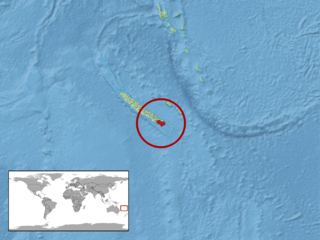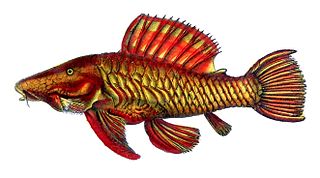
The orange-bellied burrowing skink is a skink. It is monotypic in the genus Simiscincus. It is endemic to New Caledonia.

Chloroflexus aurantiacus is a photosynthetic bacterium isolated from hot springs, belonging to the green non-sulfur bacteria. This organism is thermophilic and can grow at temperatures from 35 °C to 70 °C. Chloroflexus aurantiacus can survive in the dark if oxygen is available. When grown in the dark, Chloroflexus aurantiacus has a dark orange color. When grown in sunlight it is dark green. The individual bacteria tend to form filamentous colonies enclosed in sheaths, which are known as trichomes.

Diplacus aurantiacus, the sticky monkey-flower or orange bush monkey-flower, is a flowering plant that grows in a subshrub form, native to southwestern North America from southwestern Oregon south through most of California. It is a member of the lopseed family, Phrymaceae. It was formerly known as Mimulus aurantiacus.

Parancistrus is a small genus of suckermouth armored catfishes native to South America.
Veigaiidae is a family of mites belonging to the superorder Parasitiformes. However they are not parasitic but free-living and predatory and are found in soil and decaying organic matter. Some species are specialists of rocky shorelines. Members of this family can be distinguished by a hyaline appendage on the tarsus of the pedipalp.
Gamasolaelaps bellingeri is a species of mite belonging to the family Veigaiidae. The female is only 0.5 mm in length, the male even smaller. Both can be recognized by the dorsal sclerotized shield being deeply incised laterally. This species is found in damp habitats such as moss and leaf litter in Jamaica.

Cristiceps aurantiacus, is a species of clinid found around New South Wales, Australia and New Zealand it can be found in tide pools and the subtidal zone to a depth of 30 metres (98 ft). Its diet consists of crustaceans and small fishes. It can reach a length of 22 centimetres (8.7 in) TL.

The sepia stingray is a species of fish in the family Urolophidae. It is found in Japan, Taiwan, Vietnam, possibly North Korea, and possibly South Korea. It is threatened by habitat loss.

The variable checkerspot or Chalcedon checkerspot is a butterfly in the family Nymphalidae. It is found in western North America, where its range stretches from Alaska in the north to Baja California in the south and extends east through the Rocky Mountains into Colorado, Montana, New Mexico and Wyoming. The butterfly is usually brown or black with extensive white and yellow checkering and some red coloration on the dorsal wing. Adult wingspan is 3.2–5.7 cm (1.3–2.2 in). Adult butterflies feed on nectar from flowers while larvae feed on a variety of plants including snowberry (Symphoricarpos), paintbrush (Castilleja), Buddleja, Diplacus aurantiacus and Scrophularia californica.
Gamasolaelaps arborescens is a species of mite in the family Veigaiidae.
Gamasolaelaps bidentis is a species of mite in the family Veigaiidae.
Gamasolaelaps excisus is a species of mite in the family Veigaiidae.
Gamasolaelaps multidentatus is a species of mite in the family Veigaiidae.
Gamasolaelaps pygmaeus is a species of mite in the family Veigaiidae.
Gamasolaelaps tuberculatus is a species of mite in the family Veigaiidae.
Gamasolaelaps whartoni is a species of mite in the family Veigaiidae.
Phallus aurantiacus is a species of fungus in the stinkhorn family. It has been found in Nigeria.

Dichromanthus aurantiacus is a terrestrial species of orchid. It is native to much of Mexico, Guatemala, Honduras and El Salvador. It is a common and conspicuous weed in fallow fields in much of the region.
Acontias aurantiacus, the golden blind legless skink, is a species of lizard in the family Scincidae. It is found in Zimbabwe, Mozambique, Botswana, and South Africa.







